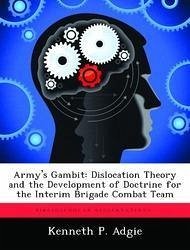This monograph analyzes whether dislocation theory is an appropriate military theory for the Interim Brigade Combat Team (IBCT) to use in developing its warfighting doctrine. It argues that the IBCT's unique mission, force structure, strengths, and weaknesses requires its leaders to mentally shift from the tactics, techniques, and procedures of legacy, firepower based forces. Dislocation theory's strength is that it does not focus on the destruction of the enemy force, but deters the enemy through combat potential, making it a suitable theory across the spectrum of conflict. This monograph reviews the purpose of studying theory and the positive impact it has on leaders, soldiers, and units. The evolution of U.S. Army doctrine from 1939 to the present is analyzed to determine how political decision, the threats, and technology influence doctrine. Field Manual 3-0, Operations, is reviewed and concludes that the emerging Army doctrine not only supports dislocation theory, but each share similar concepts.
Hinweis: Dieser Artikel kann nur an eine deutsche Lieferadresse ausgeliefert werden.
Hinweis: Dieser Artikel kann nur an eine deutsche Lieferadresse ausgeliefert werden.








